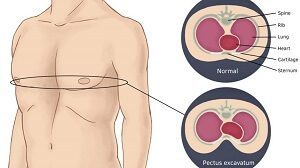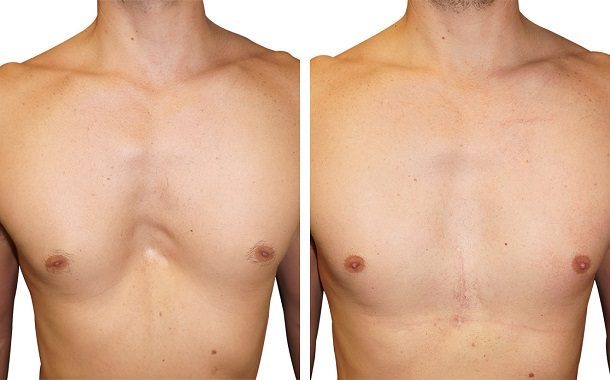Pectus Excavatum Surgery Cost
Last Updated on December 31, 2023
Written by CPA Alec Pow | Content Reviewed by ![]() CFA Alexander Popinker
CFA Alexander Popinker
The clogged sternum (pectus excavatum) is a congenital deformity of the anterior thoracic wall. It is also known as the funnel chest. Along with the thoracic hull (pectus carenatum) are the most common congenital malformations of the anterior thoracic wall. The rate of occurrence of this malformation is 1 case per 1000 newborns. The deformity becomes more obvious with increasing age; at the same time, the symptoms worsen in adolescence.
The clinical signs that young people show are due to the compression that the clogged sternum puts on the intrathoracic organs (heart, lungs). The most common symptoms are related to physical exertion (fatigue, chest pain, heaviness in breathing) which can mark young people with this malformation. A very important thing for a teenager with such a noticeable malformation is the “mental” abuse that these young people perceive from their colleagues. Serious damage to the psyche of these young people is noticed, leading to severe depression that requires a visit to a psychiatrist and appropriate treatment.
All of these arguments fully justify the development of surgical methods to correct this malformation.
How Much Does Pectus Excavatum Surgery Cost?
According to the online posts made by the people who had this surgery, the average cost of pectus excavatum surgery starts at $15,500 and goes up to more than $45,500, without health insurance.
However, longer hospital stays could result in a cost around the six-figure mark. The price of this surgery will be influenced by some factors such as the gravity of the case, the hospital you choose, the type of surgery, other appointments and inclusions with the bill, plus the health insurance and if there is any.
You might also like our articles about the cost of back surgery, heart surgery, or sciatica treatment.
Members of the Pectusinfo.com forum thread said that they had to pay anywhere between $30,500 and more than $90,500 without any health insurance. One member of this forum said that he had to pay around $28,500 for the insertion, plus another $14,500 for the removal. Also, other members who got this surgery at the Milwaukee Children’s Hospital said that they had to pay around $50,500, but they were able to negotiate the price and, in the end, paid only $36,500.
From a blog post on PectusKnowledge.com, we found out that the Nuss Procedure costs around $57,000 and this includes the expenses with the supplies, medicines, room and board, EKG, anesthesia, radiologist fees, lab work, pulmonary function test, and physical therapy.
Pectus excavatum surgery details
Currently, the surgical treatment of this condition is limited to 3 types of interventions, fully accepted worldwide.
- For symmetrical deformation, the most frequently used minimally invasive procedure for correcting a clogged sternum is used (Nuss technique).
- For complex deformities, Ravitch-type stern chondroplasty is still used, with the use of an osteosynthesis kit (Stratos kit).
- Plastic surgeons approach this pathology using silicone implants in the sternal pit, thus correcting only the aesthetic aspect, without solving the functional problems that these patients have.
What are the extra costs?
 Expect to receive many hospital stay bills besides the estimates presented above. These may include the radiologist fees, the anesthesiologist fees, and the surgeon fees, to name just a few. Make sure you talk with the hospital before the surgery to know what expense will you have to cover.
Expect to receive many hospital stay bills besides the estimates presented above. These may include the radiologist fees, the anesthesiologist fees, and the surgeon fees, to name just a few. Make sure you talk with the hospital before the surgery to know what expense will you have to cover.
Before the surgery is even considered you will have to go through multiple consultations and tests such as MRI/CT scans, metal allergy tests, a pulmonary function test, a heart sonogram, and many more, depending on the gravity of the problem. The costs of these tests may reach thousands of dollars, besides the prices mentioned above.
After the surgery, the doctor will prescribe you medication and this could cost you more than $1,200 if you don’t have health insurance.
Also, after the surgery, you will have to go to physical therapy and the cost per session will be around $110 without insurance.
There are situations when you have to travel a long distance to find a good surgeon to perform this surgery. So, you should consider the travel and accommodation costs as well.
The metal struts will have to be removed after two to four years from the insertion surgery. This procedure will take less than one hour and is done in an outpatient way. Depending on the hospital’s billing policy, this may be an extra cost to take into consideration.
Important things to consider
The Nuss procedure, which is most widely used, involves placing a pre-curved stainless steel blade behind the sternum, under general anesthesia, using a thoracoscopy kit, thus correcting the sternal deformity. The blades are of different sizes, chosen according to the patient’s age, and are fixed to the chest wall by stabilizers made of the same material. Basically, the patient will have in the end, after the surgery, which lasts around an hour and a half, only three incisions, two on the right hemithorax and one on the left hemithorax, 1.5-2 cm in size.
The patient’s postoperative recovery is rapid, following the express instructions he will receive at discharge. The blade is stored for 2-4 years, during which the corrected sternum will stabilize permanently in the corrected position.
How can I save money?
Make sure you ask your health insurance provider covers the costs of the pectus excavatum surgery. There are insurance companies that will cover this cost only if the procedure is deemed medically necessary. However, some doctors consider that this is just a cosmetic surgical procedure, so most companies will not cover the costs.
In case you don’t have health insurance talk with the finance department of the hospital and see if they can offer a low-interest finance plan or a cash discount.


Leave a Reply
Want to join the discussion?Feel free to contribute!